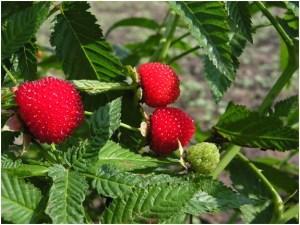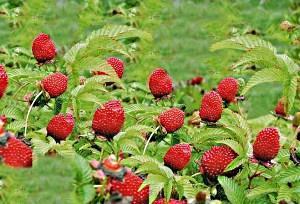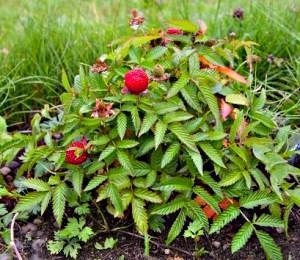Pink-leaved raspberry - prickly beauty
 Fans of ornamental gardening and unusual crops will certainly be interested in rose-leaved raspberry, which has many different names.
Fans of ornamental gardening and unusual crops will certainly be interested in rose-leaved raspberry, which has many different names.
This culture is sometimes called:
- Raspberry Tibetan due to the fact that the natural sources of its origin are in the Himalayas.
- Rosalyn - this name stuck in the Baltic countries, from where the plant smoothly migrated to our latitudes.
- Strawberry raspberry - for the flavor inherent in the fruit.
Raspberry pink (rose-leaved), despite the name and active fruiting, is considered more as an ornamental than a fruit crop.
Appearance and vegetation of rose-leaved raspberry
Rose-leaved raspberry grows as a shrub, the height of the shoots of which ranges from 60 cm to 1.5 m, depending on conditions and care. The foliage is pale green, jagged, corrugated, very beautiful.

The fruits are bright coral, very large, some reach 3 cm in diameter (about the size of a walnut), directed upwards, do not hide under foliage and are visible from afar.
In general, most of the season, rose-leaved raspberry is a beautiful bush, decorated with flowers and fruits, at first light green, then bright soft red.
Such beauty, growing by the fence or on the lawn, attracts the eyes of all passers-by.
There are also drawbacks in raspberry rosacea, which significantly limits interest in its reproduction:
- Firstly, it is the indistinct taste of berries, which cannot be compared with real raspberries.
- Secondly, the shrub is very thorny. The thorns are shaped like pink or rosehip bushes and grow not only on the branches, but also on the back of the foliage. It is recommended to stay near it only in gloves and closed work clothes, to avoid scratches.
Planting pink-leaved raspberries
Rose-leaved raspberry is not a very demanding plant, but you need to know some rules for care.
Planting pink-leaved raspberries is done in the fall before the onset of frost. With spring planting, survival rate is much worse.
 The plant prefers open areas under the sun and fertile areas. In the early years it needs enhanced irrigation until the plant is fully established.
The plant prefers open areas under the sun and fertile areas. In the early years it needs enhanced irrigation until the plant is fully established.
When planting raspberries, it must be remembered that, like all raspberries, they quickly multiply by root shoots. She needs to take a place where raspberries will not interfere with other plants or fence off the plantings by digging metal or slate sheets deep into the ground, which are impervious to roots. In places of their natural growth, raspberries are considered a weed plant for their rapid growth.
Given the strong thorniness of the bushes, they can be planted along fence... Thick leafy branches keep not only people, but also dogs and cats out of the garden. Can be planted in separate bushes on lawns or in areas where there is no other vegetation.
If you don't want pink raspberries to take up too much space, they put them in a barrel or a spacious pot and drop them in a permanent place.
The first crop appears in the third or fourth year after planting the bushes in the soil.
Before deciding to plant a pink-leaved raspberry, remember that if it grows, it will be as difficult to remove it as a blackberry or regular raspberry.Plants are regenerated from the roots remaining in the soil.
Rose Raspberry Care
Care for pink-leaved raspberries consists in weeding, shallow loosening and watering in especially dry weather. To prevent the topsoil from drying out, it is recommended mulch the soil, especially in young, rarely growing plants.
The plant does not need winter shelters, the roots winter well in any frost.
During the fall and winter, all the stems die off; in the spring they can be carefully cut and burned. Do not forget that you need to work with gloves, as thorns on dead shoots do not lose their thorniness.
Raspberry grows quickly, begins to bloom and bear fruit on the shoots that have grown in the current year.
Harvesting is done as it ripens. The berries are juicy, but do not have a specific taste. Recommended for children, as they do not cause allergies.
In preparations, together with other fruits, it brings a strawberry smell to preserves and jams. Can be used with currants or other fruits.
In the countries of the East, the fruits of pink raspberries are equated with vegetables and are used in salads with tomatoes, salt and pepper.
For commercial purposes, the fruits are not used due to their low transportability.
How much useful material on the resource pages. Here is another unfamiliar interesting plant presented - pink raspberry. I was attracted by the information that the root shoots are not afraid of frosts. To prevent the roots from scattering, you can immediately make a frame in the ground before planting. Beautiful green, ever-blooming thorny shrub, ideal for thorny hedges. It remains to find the planting material.
as far as I know, this raspberry is called rose-leaved, not pink-leaved. check and don't mislead people.